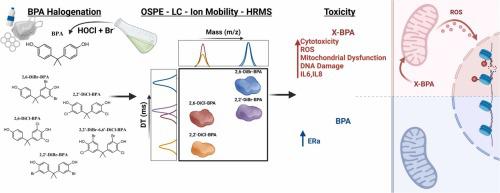当前位置:
X-MOL 学术
›
J. Hazard. Mater.
›
论文详情
Our official English website, www.x-mol.net, welcomes your
feedback! (Note: you will need to create a separate account there.)
Formation of halogenated forms of bisphenol A (BPA) in water: Resolving isomers with ion mobility – mass spectrometry and the role of halogenation position in cellular toxicity
Journal of Hazardous Materials ( IF 12.2 ) Pub Date : 2023-12-13 , DOI: 10.1016/j.jhazmat.2023.133229
Mauricius Marques Dos Santos 1 , Caixia Li 1 , Shenglan Jia 1 , Mikael Thomas 2 , Hervé Gallard 2 , Jean-Philippe Croué 2 , Pascal Carato 3 , Shane Allen Snyder 1
Journal of Hazardous Materials ( IF 12.2 ) Pub Date : 2023-12-13 , DOI: 10.1016/j.jhazmat.2023.133229
Mauricius Marques Dos Santos 1 , Caixia Li 1 , Shenglan Jia 1 , Mikael Thomas 2 , Hervé Gallard 2 , Jean-Philippe Croué 2 , Pascal Carato 3 , Shane Allen Snyder 1
Affiliation

|
Halogenated BPA (XBPA) forms resulting from water chlorination can lead to increased toxicity and different biological effects. While previous studies have reported the occurrence of different XBPAs, analytical limitation have hindered the analysis and differentiation of the many potential isomeric forms. Using online solid-phase extraction - liquid chromatography - ion-mobility - high-resolution mass spectrometry (OSPE-LC-IM-HRMS), we demonstrated a rapid analysis method for the analysis of XBPA forms after water chlorination, with a total analysis time of less than 10 min including extraction and concentration and low detection limits (∼5–80 ng/L range). A multi in-vitro bioassay testing approach for the identified products revealed that cytotoxicity and bioenergetics impacts were largely associated with the presence of halogen atoms at positions 2 or 2’ and the overall number of halogens incorporated into the BPA molecule. Different XBPA also showed distinct impacts on oxidative stress, peroxisome proliferator-activated receptor gamma - PPARγ, and inflammatory response. While increased DNA damage was observed for chlorinated water samples (4.14 ± 1.21-fold change), the additive effect of the selected 20 XBPA studied could not explain the increased DNA damage observed, indicating that additional species or synergistic effects might be at play.
中文翻译:

在水中形成卤化形式的双酚 A (BPA):利用离子淌度分辨异构体 - 质谱和卤化位置在细胞毒性中的作用
水氯化产生的卤代 BPA (XBPA) 形式会导致毒性增加和不同的生物效应。虽然以前的研究报道了不同 XBPA 的出现,但分析限制阻碍了许多潜在异构体形式的分析和区分。使用在线固相萃取 - 液相色谱 - 离子淌度 - 高分辨率质谱 (OSPE-LC-IM-HRMS),我们展示了一种用于分析水氯化后 XBPA 形式的快速分析方法,包括提取和浓缩在内的总分析时间不到 10 min,检测限低(∼5–80 ng/L 范围)。对已鉴定产品的多体外生物测定测试方法显示,细胞毒性和生物能量学影响在很大程度上与位置 2 或 2' 处的卤素原子的存在以及 BPA 分子中掺入的卤素总数有关。不同的 XBPA 还显示出对氧化应激、过氧化物酶体增殖物激活受体 γ - PPARγ 和炎症反应的不同影响。虽然观察到氯化水样品的 DNA 损伤增加(变化 4.14 ± 1.21 倍),但选定的 20 XBPA 研究的加性效应无法解释观察到的 DNA 损伤增加,表明其他物种或协同效应可能在起作用。
更新日期:2023-12-13
中文翻译:

在水中形成卤化形式的双酚 A (BPA):利用离子淌度分辨异构体 - 质谱和卤化位置在细胞毒性中的作用
水氯化产生的卤代 BPA (XBPA) 形式会导致毒性增加和不同的生物效应。虽然以前的研究报道了不同 XBPA 的出现,但分析限制阻碍了许多潜在异构体形式的分析和区分。使用在线固相萃取 - 液相色谱 - 离子淌度 - 高分辨率质谱 (OSPE-LC-IM-HRMS),我们展示了一种用于分析水氯化后 XBPA 形式的快速分析方法,包括提取和浓缩在内的总分析时间不到 10 min,检测限低(∼5–80 ng/L 范围)。对已鉴定产品的多体外生物测定测试方法显示,细胞毒性和生物能量学影响在很大程度上与位置 2 或 2' 处的卤素原子的存在以及 BPA 分子中掺入的卤素总数有关。不同的 XBPA 还显示出对氧化应激、过氧化物酶体增殖物激活受体 γ - PPARγ 和炎症反应的不同影响。虽然观察到氯化水样品的 DNA 损伤增加(变化 4.14 ± 1.21 倍),但选定的 20 XBPA 研究的加性效应无法解释观察到的 DNA 损伤增加,表明其他物种或协同效应可能在起作用。































 京公网安备 11010802027423号
京公网安备 11010802027423号